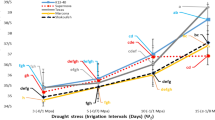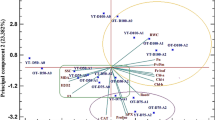Abstract
The use of reflective materials has become commonplace in agriculture as the negative effects of drought, high temperature limitation, and solar radiation on plant physiology have been better understood. This study was conducted to compare the effects of different reflective materials on some physiological characteristics of almond trees. For this purpose, a method was developed in which two solid and two transparent reflective materials were foliar sprayed at two different doses in two different deficit irrigated almond orchards (cv. ‘Ferragnes’) in 2021. Net photosynthesis rate, stomatal conductance (gS), leaf temperature (Tleaf), relative water content (RWC), SPAD chlorophyll index, proline (P), malondialdehyde (MDA), as well as some macro- and micro-nutrient contents of leaf samples taken from the treated trees were examined. The applications reduced Tleaf from 2.7 to 7.9 °C. Generally, titanium dioxide (TiO2) 0.50% and 0.25% doses consistently reduced Tleaf. The effect of reflective materials on photosynthesis was not clear. TiO2 0.25% consistently increased gS irrigated with ET75 (irrigated at %75 crop evapotranspiration, full season). The RWC of TiO2 0.25% and 0.50% treatments was the highest in the first and second measurements. Micronized calcite (CaCO3) 2.5% and 1.25% had a negative effect on RWC after the second treatment in severe drought conditions. However, there was no difference in ET75. The treatments had a significant effect on SPAD. The results of kaolin (KAO) 5% and CaCO3 1.25% treatments were significant, but the result was not clear.



Similar content being viewed by others
References
Alonso JM (2017) Environmental requirements. In: Socias i Company R, Gradziel TM (eds) Almond botany, production and uses-environmental requirements, 8th edn. CABI, Boston, pp 254–278
Alvarez HL, Di Bella CM, Colavita GM, Oricchio P, Straschnoy J (2015) Comparative effects of kaolin and calcium carbonate on apple fruit surface temperature and leaf net CO2 assimilation. J Appl Hortic 17(3):176–180. https://doi.org/10.37855/jah.2015.v17i03.33
Azizi A, Hokmabadi H, Piri S, Rabiei V (2013) Effect of kaolin application on water stress in pistachio cv. ‘Ohadi. J Nuts 4(4):9–14. https://doi.org/10.22034/JON.2013.515701
Bates LS, Waldren RA, Teare ID (1973) Rapid determination of free proline for water-stress studies. Plant Soil 39:205–207
Bernardo S, Dinis LT, Luzio A et al (2017) Kaolin particle film application lowers oxidative damage and DNA methylation on grapevine (Vitis vinifera L.). Environ Exp Bot 139:39–47. https://doi.org/10.1016/j.envexpbot.2017.04.002
Cantore V, Pace B, Albrizio R (2009) Kaolin-based particle film technology affects tomato physiology, yield and quality. Environ Exp Bot 66(2):279–288. https://doi.org/10.1016/j.envexpbot.2009.03.008
Chamchaiyaporn T, Jutamanee K, Kasemsap P, Vaithanomsat P, Henpitak C (2013) Effects of kaolin clay coating on mango leaf gas exchange, fruit yield and quality. Agric Nat Resour 47:479–491
Colavita GM, Blackhall V, Valdez S (2010) Effect of kaolin particle films on the temperature and solar injury of pear fruits. In: XI Intern Pear Symp, General Roca, pp 609–615
Diniz AP, Kozovits AR, De Carvalho LC, De Abreu AT, Leite MGP (2019) Quantitative analysis of plant leaf elements using the LA-ICP-Ms technique. Int J Mass Spectrom 435:251–258. https://doi.org/10.1016/j.ijms.2018.10.037
Faghih S, Zamani Z, Fatahi R, Omidi M (2021) Influence of kaolin application on most important fruit and leaf characteristics of two apple cultivars under sustained deficit irrigation. Biol Res 54(1):1–15. https://doi.org/10.1186/s40659-020-00325-z
FAO (2022) Food and agriculture organization, crop statistics. http://fao.org/faostat/en/#data/QC. Accessed 4 Sept 2023
Gharaghani A, Javarzari AM, Vahdati K (2018) Kaolin particle film alleviates adverse effects of light and heat stresses and improves nut and kernel quality in Persian walnut. Sci Hortic 239:35–40. https://doi.org/10.1016/j.scienta.2018.05.024
Gharaghani A, Javarzari AM, Rezaei A, Nejati R (2023) Kaolin spray improves growth, physiological functions, yield, and nut quality of ‘Tardy Nonpareil’ almond under deficit irrigation regimens. Erwerbs-Obstbau 65(4):989–1001. https://doi.org/10.1007/s10341-022-00732-4
Glenn DM, Puterka GJ (2005) Particle films: a new technology for agriculture. Hortic Rev 31:1–44. https://doi.org/10.1002/9780470650882.ch1
Glenn DM, Puterka GJ, Drake SR, Unruh TR, Knight AL, Baherle P, Prado E, Baugher TA (2001) Particle film application influences apple leaf physiology, fruit yield, and fruit quality. J Am Soc Hortic Sci 126(2):175–181. https://doi.org/10.21273/JASHS.126.2.175
Jifon JL, Syvertsen JP (2003) Kaolin particle film applications can increase photosynthesis and water use efficiency of ‘Ruby Red’ grapefruit leaves. J Am Soc Hortic Sci 128(1):107–112. https://doi.org/10.21273/JASHS.128.1.0107
Karaat FE, Denizhan H (2023) The effects of different particle film applications on almond trees. Ciência Rural 53(3):1–9. https://doi.org/10.1590/0103-8478cr20210757
Khaleghi E, Arzani K, Moallemi N, Barzegar M (2015) The efficacy of kaolin particle film on oil quality indices of olive trees (Olea europaea L.) cv. ‘Zard’ grown under warm and semi-arid region of Iran. Food Chem 166:35–41. https://doi.org/10.1016/j.foodchem.2014.06.006
Kılıç N (2014) The effects of kaolin application on the fruit quality in walnut cultivation. Cukurova University (Dissertation)
Lamaoui M, Jemo M, Datla R, Bekkaoui F (2018) Heat and drought stresses in crops and approaches for their mitigation. Front Chem 6(26):1–14. https://doi.org/10.3389/fchem.2018.00026
Lombardini L, Harris MK, Glenn DM (2005) Effects of particle film application on leaf gas exchange, water relation, nut yield and insect populations in mature pecan trees. Hort Sci 40(5):1376–1380. https://doi.org/10.21273/HORTSCI.40.5.1376
Mahalakshmi BK, Rao DVS, Rao GR, Reddy PJ (1999) Management of drought with anti-transpirants in chili (Capsicum annum L.). South Indian Hortic 47(1):86–88
Mahmoudian M, Rahemi M, Karimi S, Yazdani N, Tajdini Z, Sarikhani S, Vahdati K (2021) Role of kaolin on drought tolerance and nut quality of Persian walnut. J Saudi Soc Agric Sci 20(6):409–416. https://doi.org/10.1016/j.jssas.2021.05.002
Maletsika PA, Nanos GD (2013) Kaolin particle film on peach leaf physiology. In: VIII. International Peach Symposium 17.06.. Matera 1084, pp 327–334
Micke WC (1996) Almond production manual. UCANR Publications, Richmond, p 279
Mohamad ME, Awad AA, Gendy AS (2021) Influence of calcium carbonate and kaolin on growth, drought resistance index and physiological traits of paulownia (Paulownia tomentosa, Thunb) seedlings under drought stress conditions. Plant Arch 21(1):665–671. https://doi.org/10.51470/PLANTARCHIVES.2021.v21.no1.092
Nanos GD, Kazantzis I, Kefalas P, Petrakis C, Stavroulakis GG (2002) Irrigation and harvest time affect almond kernel quality and composition. Sci Hortic 96(1–4):249–256
Ntanos E, Tsafouros A, Denaxa NK, Kosta A, Bouchagier P, Roussos PA (2022) Mitigation of high solar irradiance and heat stress in kiwifruit during summer via the use of alleviating products with different modes of action—Part 1 Effects on leaf physiology and biochemistry. Agriculture 12(12):2121. https://doi.org/10.3390/agriculture12122121
Rajinder SD, Dhindsa PP, Thorpe TA (1981) Leaf Senescence: Correlated with increased levels of membrane permeability and lipid peroxidation, and decreased levels of superoxide dismutase and catalase. J Exp Botany 32:93–101. https://doi.org/10.1093/jxb/32.1.93
Rosati A, Metcalf SG, Buchner RP, Fulton AE, Lampinen BD (2006) Physiological effects of kaolin applications in well-irrigated and water-stressed walnut and almond trees. Ann Bot 98:267–275
Sade N, Galkin E, Moshelion M (2015) Measuring arabidopsis, tomato and barley leaf relative water content (RWC). Bio Protoc 5:1451. https://doi.org/10.21769/BioProtoc.1451
Socias i Company R, Ansón MJ, Espiau MT (2017) Taxonomy, botany and physiology. In: Socias i Company R, Gradziel TM (eds) Almonds: botany, production and uses, 8th edn. CABI, Boston, pp 1–42
Sotelo-Cuitiva YM, Restrepo-Díaz H, García-Castro A, Ramírez-Godoy A, Flórez-Roncancio VJ (2011) Effect of kaolin film particle applications (Surround WP®) and water deficit on physiological characteristics in rose cut plants (Rose spp L.). AJPS 2(3):354–358. https://doi.org/10.4236/ajps.2011.23040
Sotiropoulos T, Petridis A, Koukourikou-Petridou M, Koundouras S (2016) Evaluation of ‘Sun Protect’ in protecting apples (Malus × domestica Borkh.) against sunburn. Hortic Sci 43(4):175–180. https://doi.org/10.17221/200/2015-HORTSCI
Stocker T (2013) Climate change 2013: the physical science basis: working group I contribution to the fifth assessment report of the intergovernmental panel on climate change. University press, Cambridge
Yücel M (2010) The effects of kaolin clay application on the growth and development of watermelon plants (Citrillus lanatus (Thunb.) Matsum and Nakai) grown under high temperature stress. Sütçü İmam University (Dissertation)
Funding
The study was funded by the Southeast Anatolia Project Regional Development Administration. All data underlying the results are available as part of the article and no additional source data are required.
Author information
Authors and Affiliations
Corresponding author
Ethics declarations
Conflict of interest
H. Denizhan, A. İkinci and F.E. Karaat declare that they have no competing interests.
Additional information
Publisher’s Note
Springer Nature remains neutral with regard to jurisdictional claims in published maps and institutional affiliations.
Rights and permissions
Springer Nature or its licensor (e.g. a society or other partner) holds exclusive rights to this article under a publishing agreement with the author(s) or other rightsholder(s); author self-archiving of the accepted manuscript version of this article is solely governed by the terms of such publishing agreement and applicable law.
About this article
Cite this article
Denizhan, H., İkinci, A. & Karaat, F.E. Physiological Influences of Solid and Transparent Foliar Reflective Material Treatments in Almond Trees. Applied Fruit Science (2024). https://doi.org/10.1007/s10341-024-01059-y
Received:
Accepted:
Published:
DOI: https://doi.org/10.1007/s10341-024-01059-y




